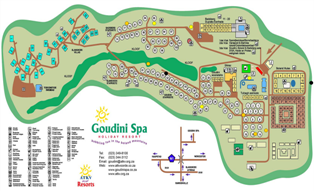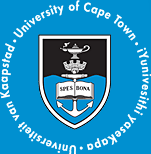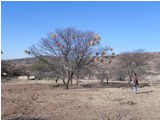PAOC Conference at Goudini Spa, 7-12 Sep 2008
The 12th Pan African Ornithological Congress, was held on 7-12 September 2008 at Goudini Spa
For the first time at an international conference, there was a symposium devoted to weavers (there have been meetings and conferences dedicated to the pest Red-billed Quelea). The talks and abstracts are listed below.
Ringing at the PAOC
There was some ringing in the mornings. Unfortunately the weather was not ideal for ringing, with lots of cold and rain. However, 44 birds were caught in mistnets and spring-traps, including 6 Southern Masked Weavers. Some birds from the previous year were recaptured, including 1 Southern Masked Weaver.
Southern Masked Weaver colonies at Goudini Spa
The map shows colonies seen the previous year (28 November 2007) and during the PAOC. Colonies are shown as coloured dots:
Black dots – 2007 only (2 colonies)
Yellow dots – col 2007 & 2008 (4 colonies)
Orange dots – col 2008 only (5 colonies)
 Click here for larger map (337 kB)
Click here for larger map (337 kB)
Weaver symposium at the PAOC
The following talks were given in the symposium, chaired by Adrian Craig and myself. The author, title and abstract are given. Weaver posters are not listed here (yet).
- H. Dieter Oschadleus, Range expansion in the Southern Masked Weaver Ploceus velatus
The historical distribution of the Southern Masked Weaver Ploceus velatus covered the Eastern Cape and KwaZulu-Natal inland to Botswana and Namibia and north to southern Angola, Zambia, Zimbabwe and presumably Mozambique. The first published record of this species in the Western Cape was in 1940. In the last century it has expanded its range to the Western Cape and western Northern Cape. This paper investigates ecological and demographic factors in the range expansion of the Southern Masked Weaver. This expansion probably occurred due to farming activities in the Northern Cape Karoo, i.e. building dams and weirs, irrigated cultivation and tree planting. Away from human habitation it was able to expand its range in the Nama Karoo by the spread of the alien Prosopis tree. Several newly discovered records of this species in the Western Cape earlier than 1940 indicate that the major rivers (the Breede and Berg Rivers) were used as corridors to cross the Cape mountains. Thus ecologically the weaver has adapted to a variety of habitats to enable its spread across the barriers of the arid Karoo and steep mountains. Current research is investigating the demographic aspects of this range expansion by studying the survival rate and breeding success of this weaver. These are compared to those of the Cape Weaver P. capensis, a bird with a less extensive world distribution. The Cape and Southern Masked Weavers were studied on the Cape Peninsula during 2006 and 2007, checking nests for breeding productivity (which is similar in the two species) and regular ringing for survival analysis (higher in Southern Masked than Cape Weavers).
- Hendrik Reers & Alain Jacot, Identity signalling and signals of need in begging calls of Ploceus weavers
The begging behaviour of a young bird plays a crucial role during its early life. It is well established that begging calls signal the chick's hunger level to the feeding parents. However, in many species begging may additionally serve as a signal of identity or kin during the post-fledging phase with parental care where parents have to reliably locate their offspring within a colony of conspecifics. We predict that begging calls will include dynamic components reliably indicating the hunger level, and static traits that reflect the identity independent of hunger level. Ploceus weavers are ideal to study these two signalling mechanisms because they breed in huge colonies, the breeding onset and, consequently, the time of fledging is highly synchronized and chicks still rely on parental food provisioning once they have fledged. In a combination of different field studies with colonially breeding Ploceus weavers, we try to disentangle age-, gender-, family- and hunger-related variation in begging calls, in order to understand the evolution of the multiple acoustic components within the complex begging calls.
Here, we are going to focus on the ontogeny of begging calls from hatching to fledging in different species of Ploceus weaver nestlings. Specifically, we will present data about the plastic development of potential identity and hunger-related calling components with special interest on the period close to fledging. Differences in the development of calling parameters among and within species indicate which acoustic parameters in a chick's begging call show potential for individual recognition, which is crucial for the reliable recognition of chicks by parents during the extended post-fledging phase. - Alice U. Aidnik & Thomas W.P. Friedl, Who’s the boss? Dominance and plumage coloration in male-male competition in the Southern Red Bishop (Euplectes orix)
In many species, secondary sexual characters serve a dual role in intra- and intersexual selection. In birds their visual signals, such as plumage characteristics, have a key function in these selection processes. We studied the role of plumage coloration in males of the Southern Red Bishop (Euplectes orix), a sexually dimorphic and polygynous weaverbird species occurring in sub-Saharan Africa and breeding in colonies around water. Using male-male competition over a limited food source, we wanted to determine if ornamentation in this species serves as a dominance signal between individuals. If the orange-red breeding plumage functions as a badge of status and is used to assess individual fighting ability, those males with redder and/or brighter plumage should be dominant over those with duller plumage. To determine if and which plumage characteristics function as status badges, we conducted two sets of experiments, both of which consisted of dyadic contests over a limited food source. In the first set of experiments, we staged contests between unfamiliar and unmanipulated males. The setup of the second set of experiments was identical to the first, with the exception that the plumage of one male of each dyad was experimentally manipulated within the range of the natural plumage variation. Using several parameters such as time spent at the feeder and the number of interactions won by an individual, we were able to determine if plumage characteristics influence the outcome of these male-male contests.
- Maria Prager & Staffan Andersson, Evolution of sexually selected carotenoid coloration in widowbirds and bishops (Euplectes spp.)
Male breeding plumages of African widowbirds and bishops (Euplectes spp.) show dramatic variation in hue (yellow, orange or red) and extent (area) of their striking carotenoid-based coloration. Given similar polygynous mating systems, and presumably generalised sexual selection of more saturated and redder signals, genetic or ecological constraints seem likely to explain the diversity. As an initial step towards identifying such constraints, we reconstruct ancestral character-states and examine macroevolutionary patterns in carotenoid coloration within the genus. Parsimony and likelihood analyses are performed on discrete and continuous measures of reflectance-based hue, and patch size, each with specific relevance to signal information content (i.e. carotenoid acquisition, metabolism or deposition). Our results suggest that widowbirds and bishops derive from a yellow ancestor, subsequent to which orange or red coloration has been repeatedly gained, but later also lost in some branches. Whereas patch area and discrete hue show a strong phylogenetic signal, continuous hue ('redness') is phylogenetically labile. Results are discussed in relation to other recent reconstructions of avian display traits, and tentatively to possible mechanisms underlying carotenoid colour diversity among birds.
- Allen Spaulding & Staffan Andersson, Molecular phylogenetics of weaverbirds (Ploceinae): preliminary estimates
The comparative study by Crook (1964) on the ecology and mating systems of weaverbirds (Ploceinae) is a cornerstone of behavioural ecology. The central findings, further elaborated by Lack (1968) and Emlen & Oring (1977), were that forest species tend to be insectivorous, monogamous, and sexually monomorphic, while savanna species typically are seed-eaters, polygynous and sexually and seasonally dimorphic. However, judging from obvious congruences with current taxonomy (e.g. all Malimbus spp are monogamous insectivores, and all Euplectes spp are polygynous seed-eaters), and if these reflect phylogenetic relationships, the adaptive explanations may be invalid or at least indistinguishable from non-adaptive common ancestry. To allow phylogenetic analyses and comparative tests of the above and other aspects of this fascinating evolutionary diversification, we are working on a molecular phylogeny (mtDNA and nuclear introns) of the subfamily. Here we report our current estimate of the phylogenetic relationships among eleven weaverbird genera. We also analyse parts of the ecological radiation in the large genus Ploceus, which does not seem to be monophyletic. We discuss the results in relation to previous, morphologically based taxonomic treatments, and begin to address the problem of phylogenetic non-independence in Crook’s classic adaptive scenario.
There were additional talks on weavers in other symposia:
- H. Dieter Oschadleus, Patterns of primary moult in the weavers, Ploceidae [substitution talk, ie not in original program]
- Staffan Andersson & Maria Prager, Carotenoid pigments and metabolism in yellow and red breeding plumages of African bishops (Euplectes spp.)
Male breeding plumages of African widowbirds and bishops (Euplectes spp.) show striking variation in carotenoid-based plumage coloration, with saturated yellow or red patches. Since behavioural experiments and phylogenetic analyses (see Prager & Andersson, this conference) suggest generalized selection and convergent evolution of red coloration, the occurence of yellow species may be explained by dietary or physiological constraints on the plumage pigmentation. Here we use reflectance spectrometry and High Performance Liquid Chromatography (HPLC) to describe the species-specific colors and plumage carotenoids of several Euplectes species. A detailed analysis of the sympatric Southern Red Bishop (E. orix) and Yellow-crowned Bishop (E. afer) shows that the yellow rump colour of afer (ëR50 = 528 nm) primarily derives from the direct-deposited ‘dietary yellow’ pigments lutein and zeaxanthin. In the red plumage of orix (ëR50 = 590 nm), these pigments are complemented by smaller amounts of ‘derived red’ C4-keto-carotenoids (mainly á-doradexanthin), but also astaxanthin, cantaxanthin and adonirubin. To investigate the relative importance of nutritional and metabolic constraints behind this difference, we also performed a diet supplementation aviary experiment before and during prenuptial moult of the two species. Our results show that orix, but not afer, can manufacture ‘red’ C4-ketocarotenoids (á-doradexanthin and cantaxanthin) from ‘yellow’ dietary precursors (lutein and â-carotene). This supports the hypothesis that a metabolic (and most likely genetic) change appeared in the ancestor of all red bishop species.










